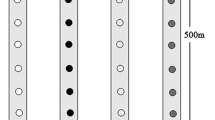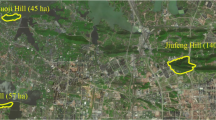Abstract
The contribution of pre-dispersal seed predation to inter-specific differences in recruitment remains elusive. In species with no resistance mechanisms, differences in pre-dispersal predation may arise from differences in seed abundance (plant satiation) or in the ability of seeds to survive insect infestation (seed satiation). This study aimed to analyse the impact of pre-dispersal acorn predation by weevils in two co-occurring Mediterranean oaks (Quercus ilex and Quercus humilis) and to compare its relevance with other processes involved in recruitment. We monitored the patterns of acorn production and acorn infestation by weevils and we conducted experimental tests of acorn germination after weevil infestation, post-dispersal predation and seedling establishment in mixed forests. Monitoring and experimental data were integrated in a simulation model to test for the effects of pre-dispersal predation in recruitment. In both oaks pre-dispersal acorn infestation decreased with increasing acorn crop size (plant satiation). This benefited Q. ilex which exhibited stronger masting behaviour than Q. humilis, with almost a single and outstanding reproductive event in 6 years. Acorn infestation was more than twice as high in Q. humilis (47.0%) as in Q. ilex (20.0%) irrespective of the number of seeds produced by each species. Although germination of infested acorns (seed satiation) was higher in Q. humilis (60%) than in Q. ilex (21%), this could barely mitigate the higher infestation rate in the former species, to reduce seed loss. Conversely to pre-dispersal predation, no inter-specific differences were observed either in post-dispersal predation or seedling establishment. Our results indicate that pre-dispersal predation may contribute to differences in seed supply, and ultimately in recruitment, between co-existing oaks. Moreover, they suggest that seed satiation can barely offset differences in seed infestation rates. This serves as a warning against overemphasising seed satiation as a mechanism to overcome seed predation by insects.



Similar content being viewed by others
References
Ashton MS, Larson BC (1996) Germination and seedling growth of Quercus (section Erythrobalanus) across openings in a mixed-deciduous forest of southern New England, USA. For Ecol Manage 80:81–94
Bacilieri R, Bouchet MA, Bran D, Grandjanny M, Maistre M, Perret P, Romane F (1993) Germination and regeneration mechanisms in Mediterranean degenerate forests. J Veg Sci 4:241–246
Bonal R, Muñoz A (2007) Multi-trophic effects of ungulate intraguild predation on acorn weevils. Oecologia 152:533–540
Bonal R, Muñoz A (2008) Seed growth suppression constrains the growth of seed parasites: premature acorn abscission reduces Curculio elephas larval size. Ecol Entomol 33:31–36
Bonal R, Muñoz A, Díaz M (2007) Satiation of predispersal seed predators: the importance of considering both plant and seed levels. Evol Ecol 21:367–380
Bran D, Lobreaux O, Maistre M, Perret P, Romane F (1990) Germination of Quercus ilex and Quercus pubescens in a Q. ilex coppice: long-term consequences. Vegetatio 87:45–50
Branco M, Branco C, Merouani H, Almeida MH (2002) Germination success, survival and seedling vigour of Quercus suber acorns in relation to insect damage. For Ecol Manage 166:159–164
Cahill S, Llimona F, Gracia J (2003) Spacing and nocturnal activity of wild boar Sus scrofa in a Mediterranean metropolitan park. Wildl Biol 9:3–13
Clark JS, Beckage B, Camill P, Cleveland B, HilleRisLambers J, Lighter J, McLachlan J, Mohan J, Wyckoff P (1999) Interpreting recruitment limitation in forests. Am J Bot 86:1–16
Crawley MJ (2000) Seed predators and plant population dynamics. In: Fenner M (ed) Seeds: the ecology of regeneration in plant communities. CAB International, Wallingford, pp 167–181
Crawley MJ, Long CR (1995) Alternate bearing, predator satiation and seedling recruitment in Quercus robur L. J Ecol 83:683–696
Espelta JM, Riba M, Retana J (1995) Patterns of seedling recruitment in West-Mediterranean Quercus ilex forests influenced by canopy development. J Veg Sci 6:465–472
Espelta JM, Cortés P, Mangirón M, Retana J (2005) Differences in biomass partitioning, leaf nitrogen content, and water use efficiency (δ 13C) result in similar performance of seedlings of two Mediterranean oaks with contrasting leaf habit. Ecoscience 14:447–454
Espelta JM, Cortés P, Molowny-Horas R, Sánchez-Humanes B, Retana J (2008) Masting mediated by summer drought reduces acorn predation in Mediterranean oak forests. Ecology 87:805–817
Fieberg J, Jenkins KJ (2005) Assessing uncertainty in ecological systems using global sensitivity analyses: a case example of simulated wolf reintroduction effects on elk. Ecol Model 187:259–280
Frey HC, Patil SR (2002) Identification and review of sensitivity analysis methods. Risk Anal 22:553–578
Garcia D, Houle G (2005) Fine-scale spatial patterns of recruitment in red oak (Quercus rubra): what matters most, abiotic or biotic factors? Ecoscience 12:223–235
George LO, Bazzaz FA (1999) The fern understory as an ecological filter: emergence and establishment of canopy-tree seedlings. Ecology 80:833–845
Gómez JM (2004) Bigger is not always better: conflicting selective pressures on seed size in Quercus ilex. Evol Int J Org Evol 58:71–80
Gracia M, Retana J, Picó FX (2001) Seedling bank dynamics in managed holm oak (Quercus ilex) forests. Ann For Sci 58:843–852
Greig N (1993) Predispersal seed predation on 5 Piper species in tropical rain-forest. Oecologia 93:412–420
Helton JC, Johnson JD, Sallaberry CJ, Storlie CB (2006) Survey of sampling-based methods for uncertainty and sensitivity analysis. Reliab Eng Syst Saf 91:1175–1209
Hulme PE, Benkman CW (2002) Granivory. In: Herrera CM, Pellmyr O (eds) Plant-animal interactions: an evolutionary approach. Blackwell, UK, pp 132–154
Jansen PA, Bongers F, Hemerik L (2004) Seed mass and mass seeding enhance dispersal by a Neotropical scatter-hoarding rodent. Ecol Monogr 74:569–589
Ke G, Werger MJA (1999) Different responses to shade of evergreen and deciduous oak seedlings and the effect of acorn size. Acta Oecol 20:579–586
Koenig WD, Knops JMH, Carmen RL, Stanback WJ, Mumme RL (1996) Acorn production by oaks in central coastal California: influence of weather at three levels. Can J For Res 26:1677–1683
Kolb A, Ehrlén J, Eriksson O (2007a) Ecological and evolutionary consequences of spatial and temporal variation in pre-dispersal seed predation. Persp Plant Ecol Evol Syst 9:79–100
Kolb A, Leimu R, Ehrlén J (2007b) Environmental context influences the outcome of a plant-seed predator interaction. Oikos 116:864–872
Kollman J, Schill HP (1996) Spatial patterns of dispersal, seed predation and germination during colonization of abandoned grassland by Quercus petraea and Corylus avellana. Vegetation 125:193–205
Leiva MJ, Fernandez-Ales R (2005) Holm-oak (Quercus ilex subsp. ballota) acorns infestation by insects in Mediterranean dehesas and shrublands: its effect on acorn germination and seedling emergence. For Ecol Manage 212:221–229
León-Camacho M, Viera-Alcaide I, Vicario IM (2004) Acorn (Quercus spp.) fruits lipids: saponifiable and unsaponifiable fractions: a detailed study. J Am Oil Chem Soc 81:447–453
Liebhold A, Sork VL, Peltonen M, Koenig W, Bjornstad ON, Westfall R, Elkinton J, Knops JMH (2004) Within-population spatial synchrony in mast seeding of North American oaks. Oikos 104:156–164
Long TJ, Jones RH (1996) Seedling growth strategies and seed size effects in fourteen oak species native to different soil moisture habitats. Trees 11:1–8
Lookingbill T, Zavala MA (2000) Spatial pattern of Quercus ilex and Quercus pubescens recruitment in Pinus halepensis dominated woodlands. J Veg Sci 11:607–612
López A, Sánchez JM (2004) Árboles en España. Manual de identificación. Mundi-Prensa, Madrid
Mack AL (1998) An advantage of large seed size: tolerating rather than succumbing to seed predators. Biotropica 30:604–608
Mendoza E, Dirzo R (2007) Seed-size variation determines interspecific differential predation by mammals in a Neotropical rain forest. Oikos 116:1841–1852
Moles AT, Westoby M (2004) Seedling survival and seed size: a synthesis of the literature. J Ecol 92:372–383
Moles AT, Warton DI, Westoby M (2003) Do small-seeded species have higher survival through seed predation than large-seeded species? Ecology 84:3148–3161
Mucunguzi P (1995) Bruchids and survival of acacia seeds. Afr J Ecol 33:175–183
Negi AS, Negi GCS, Singh SP (1996) Establishment and growth of Quercus floribunda seedlings after a mast year. J Veg Sci 7:559–564
Pérez-Ramos IM, Urbieta IR, Marañon T, Zavala MA, Kobe RK (2008) Seed removal in two coexisting oak species: ecological consequences of seed size, plant cover and seed-drop timing. Oikos 117:1386–1396
Pons J, Pausas JG (2007) Rodent acorn selection in a Mediterranean oak landscape. Ecol Res 22:535–541
Quero JL, Villar R, Maranon T, Zamora R (2006) Interactions of drought and shade effects on seedlings of four Quercus species: physiological and structural leaf responses. New Phytol 170:819–833
Sánchez-Gómez D, Valladares F, Zavala MA (2006) Functional traits and plasticity in response to light in seedlings of four Iberian forest tree species. Tree Physiol 26:1425–1433
Satake A, Bjørnstad ON, Kobro S (2004) Masting and trophic cascades: interplay between rowan trees, apple fruit moth, and their parasitoid in southern Norway. Oikos 104:540–550
Shibata M, Tanaka H, Iida S, Abe S, Masaki T, Niiyama K, Nakashizuka T (2002) Synchronized annual seed production by 16 principal tree species in a temperate deciduous forest, Japan. Ecology 83:1727–1742
Sork VL (1993) Evolutionary ecology of mast-seeding in temperate and tropical oaks (Quercus spp). Vegetation 108:133–147
Sork VL, Bramble J, Sexton O (1993) Ecology of mast-fruiting in 3 species of North-American deciduous oaks. Ecology 74:528–541
Terborgh J, Lososo E, Riley MP, Riley MB (1993) Predation by vertebrates and invertebrates on the seeds of 5 canopy tree species of an Amazonian forest. Vegetation 108:375–386
Turnbull LA, Crawley MJ, Rees M (2000) Are plant populations seed-limited? A review of seed sowing experiments. Oikos 88:225–238
Weppler T, Stöcklin J (2006) Does pre-dispersal predation limit reproduction and population growth in the alpine clonal plant Geum reptans? Plant Ecol 187:277–287
Xiao ZS, Harris MK, Zhang ZB (2007) Acorn defenses to herbivory from insects: implications for the joint evolution of resistance, tolerance and escape. For Ecol Manage 238:302–308
Acknowledgments
We thank Helena Barril, Berta Obón, Ivette Serral and Iraima Verkaik for assistance during field work. We also thank Raúl Bonal and four anonymous reviewers for helpful comments on an early draft of this manuscript. This research has been partly funded by the INIA (RTA2005-00100-CO2), MCIIN projects (CGL2008-04847-C02-02) and the Consorci del Parc de Collserola. The experiments in this paper comply with the current laws of the country in which they were performed.
Author information
Authors and Affiliations
Corresponding author
Additional information
Communicated by Katherine Gross.
Electronic supplementary material
Rights and permissions
About this article
Cite this article
Espelta, J.M., Cortés, P., Molowny-Horas, R. et al. Acorn crop size and pre-dispersal predation determine inter-specific differences in the recruitment of co-occurring oaks. Oecologia 161, 559–568 (2009). https://doi.org/10.1007/s00442-009-1394-x
Received:
Accepted:
Published:
Issue Date:
DOI: https://doi.org/10.1007/s00442-009-1394-x




